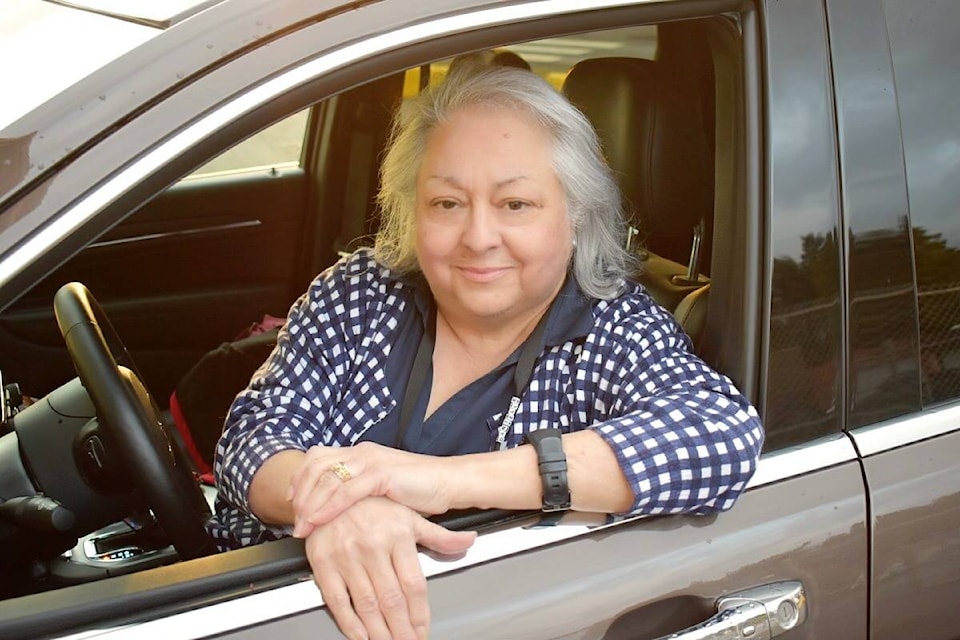While First Nations leaders, on March 24 called for renewed support and action to allow all members of society equitable access to a driver’s licence, the systemic issues run much deeper than people realize, Danielle Dalton training coordinator at Hecate Strait Employment and Development Society said.
While Indigenous community leaders have for many years identified a driver’s licence as a key to employment, well-being and safety it is currently estimated up to 75 per cent of Indigenous people living on reserve do not hold a driver’s licence. In north coastal communities the number is believed to be even higher, Dalton said.
Dalton trains hundreds of students a year in a variety of programs including drivers knowledge courses, both on and off reserve. More than 70 per cent of her students are First Nations.
“A driver’s licence is a game changer. It’s not that you have to go buy a car. A driver’s licence is a right of passage and a critical piece of identification,” she said. “It is the entry to progression.”
For many, obtaining a driving permit is cumbersome and traumatic for a variety of reasons, she said. Cost is the obvious one, however many Bands pay for their members to obtain a licence and some more proactive bands will pay for the knowledge classes and driving instruction too, Dalton said.
Barriers can stem back from birth she said as often students don’t have the required birth certificate or two required pieces of ID. It can take months to obtain these documents and students get discouraged. The treatment they receive from service personnel at agencies can be disheartening.
“Identification is inter-related to a driver’s licence. One relies on the other,” the training instructor said.
Not having a credit card, or a cellphone, or having a cellphone but no minutes or data to call to book appointments are also common barriers. The cost and accessibility to vision wear is another barrier.
“These are basic needs now. A working phone is not a luxury. There are so may barriers it is to the point where its is out of control.”
“This not just a Prince Rupert issue, it is a province wide problem in many areas of training.” she said.
With COVID-19, trainers are no longer permitted into villages or coastal communities where internet is unreliable or students do not have access to training resources such as computers or laptops. With some training courses, exams are an issue because the training course designers expect exams to be taken on line with a computer. This can not be circumvented because they will not send invigilators to supervise the tests.
“You don’t need a training school to grab the driver’s manual and read it,” Dalton said. “But you need a computer, internet, or a phone to complete a practice test or book an appointment.”
Students may also have fines that are required to be paid before obtaining a licence. These are all systemic barriers in a colonial system, Dalton said.
“There may be stigma from the fines. They are penalized if they drive without a licence, but they can’t get that licence due to numerous factors. It is a catch 22,” she said. “There is everything preventing them from getting anything.”
The barriers are not just limited to obtaining a driver’s licence. It’s a game of dominoes she said, with training and employment also being affected. First Nations Bands will send people for training such as safety or security courses to improve employment opportunities so they can hire their own members.
While a student may be very successful in the course and pass with high marks, in the end lack of a driver’s licence will obstruct them from obtaining a position.
The barriers don’t just affect those looking for employment, Dalton said.
“Women are marginalized. Women are always the last ones to get anything. It’s about being able, especially as a single mom, this is needed to help with your children. And we wouldn’t have so many women hitchhiking. It’s about safety too.”
Dalton gives the example that women could come together and carpool.
“You could have a whole bunch of women that help each other. You just need to start that wheel progressing in the right direction.”
North Coast communities are affected all the time. It’s a battle to fight for a better system,” Dalton said.
She has heard people in Prince Rupert tell her it is not worth the fight to get a driver’s licence. Current COVID-19 booking times for tests she said can be in excess of six months, with one student needing to rebook an appointment from Oct. 2020, and not being able to obtain a new test date until five months later.
“We need to get out of the small town mentality that we don’t need a driver’s licence. There is an apathy from the powers that be. Attitudes need to change at all levels. A driver’s licence equals the playing field,” she said. “If you don’t have a driver’s licence you are not equal in your opportunities.”
“Everyone says they are all in the same boat. That is just not true,” Dalton said. “We are in the same storm, but some are in luxury cruisers. Right now when it comes to driving permits the indigenous community is in a rowboat without oars.”
